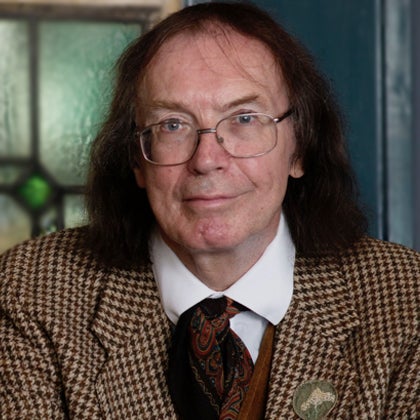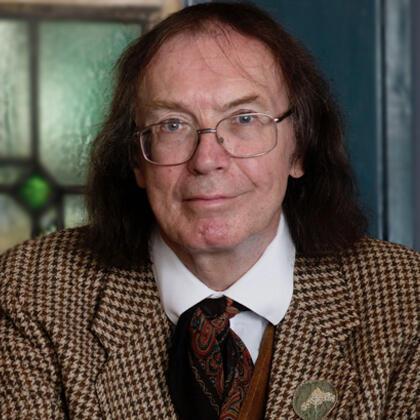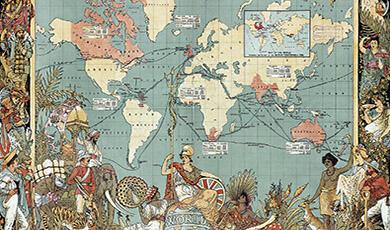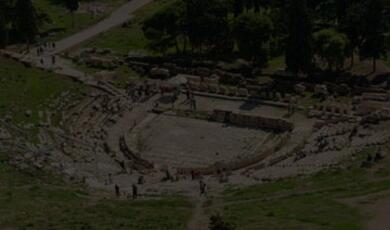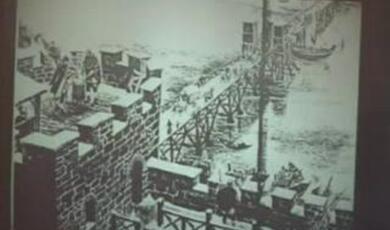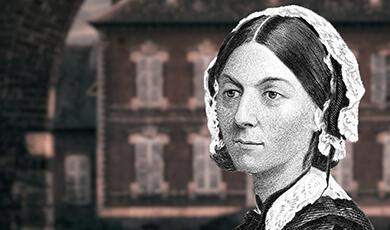Anglo-Saxon Pagan Gods
Share
- Details
- Text
- Audio
- Downloads
- Extra Reading
When the Western Roman Empire crumbled, the Anglo-Saxon peoples who occupied Britain brought their own paganism with them. This was Germanic, with a pantheon of deities that included Woden, Thunor, Tiw and Frig. Its temples were wooden structures that leave scant traces in the landscape, but you can find evidence for their beliefs in cemeteries like Sutton Hoo.
This lecture looks at such evidence and at literature such as Beowulf and the history written by the Christian scholar Bede.
Download Text
Anglo-Saxon Pagan Gods: The Evidence
Professor Ronald Hutton
1st February 2023
Although early English paganism arrived in Britain later than Roman paganism did, in a period regarded as firmly historical, much less is known about it. This is because it was a foreign importation which did not apparently combine well with any native religions, and had no time to put down deep roots. Nonetheless, it did leave permanent traces in the English landscape and made some impact on English art and literature.
Setting the Scene
The arriving Anglo-Saxons had the extraordinary experience of occupying a land which had recently gone through what scholars call a systems collapse. They found an economy and society which was very much a tribal one of petty kingdoms like their own, with subsistence farming, and wooden huts and halls. Yet all around were the imposing ruins of towns, villas, fortresses and factories. Except for the lack of ecological damage and a sudden population crash, it was like a landscape following a nuclear holocaust. It awed and troubled the newcomers, who left poems like The Wanderer to testify to the sense of melancholy and disorientation provoked by a new life among the wrecked constructions of vanished giants. This is a theme not found in other early literatures, and Anglo-Saxon writing also shows at times a tender humanity missing from other texts of the early Middle Ages. Probably only an Anglo-Saxon could have written a poem like ‘Wulf and Eadwacer’, giving voice to the complex feelings of a young woman who has just been unfaithful to her long-absent boyfriend.
The Particular Problem of Paganism
The pagan Anglo-Saxons were illiterate, and so we have no texts of theirs to testify to their beliefs and practices. Their period of residence in Britain was too short to leave archaeological material comparable with that from Roman Britain or the pre-Roman Iron Age. Early English literature is smaller in quantity than that of medieval Ireland and lacks the medieval Welsh taste for epics and tales and magic.
There is a real possibility that a typical pagan Anglo-Saxon would not have been able to describe her or his religion even if we could interview them. It shows no sign of having had either clear or universal principles. Much of what we know of it is inferred from later Christian English sources, or those of Romans, or later Icelandic literature. The latter appears to represent a Germanic style of paganism which could have been similar to that the early English. However, that paganism was long defunct by the time that the Icelanders wrote of it, and though related to the English brand was not identical.
The Textual Evidence
Deities
We know a small amount about individual Anglo-Saxon deities, from scraps of native literature, place names and (mostly) comparions with divinities in better-known pantheons. Both place names and the family trees of early English kings indicate that the most important was the god Woden. He was noted as equivalent to the Roman Mercury, the German Wotan and the Scandinavian Odin, as a patron of rulers, wisdom, voyages and skills. A tenth-century homily calls him king of the gods, and a cunning deceiver, at home on hills and crossroads. A charm calls him an enchanter. This all seems so similar to the Norse Odin that it is easy to imagine that their mythology was identical, but this is not definitely so: one of the traits of Odin was that he was one-eyed, but the main medieval picture of Woden shows him with both.
Place name frequency puts Thunor next, and makes him dominant in south-eastern England. A homily compares him to the Roman god Jupiter as a patron of thunder, weather and farming- so he was also like the Norse Thor, the German Donner and the Rhineland Taranis. His symbols were the hammer and swastika, both suggesting thunderbolts. Then there was Tiw. He was equated with the Roman Mars, and his symbol, a T, appears on weapons, so he must have been a war god. He too appears in a scatter of place names. Finally there is Frigg, who was given the day of the week that the Romans had awarded to Venus, and so was presumably also a goddess of love, fertility and abundance.
These were clearly the most important, but there are slighter traces of other deities. The kings of Essex traced their descent from a god called Seaxnet. A runic poem mentions one called Ing. A royal biographer speaks of another, Geat. The great early English historian Bede recorded two goddesses, Hreda (whose name suggests the earth) and Eostre (whose name suggests the dawn) as worshipped in spring. However, we are not sure of the reliability of any of these sources in this context. We have also almost certainly lost many tribal and local deities, as Anglo-Saxon culture lacks the sources – inscriptions and place-name stories – that record these beings in other cultures.
Holy Places
The best evidence for Anglo-Saxon shrines and temples comes from place-names. Two have been identified by philologists as especially significant, both being found in southern and eastern England. One is hearg, which seems to mean a holy place on a hill (though this is uncertain). It often ends up as ‘Harrow’, such as at Harrow-on-the-Hill, west of London, which was the chief shrine of the Middlesex clan of the Gumenings. At Harow in Sussex, a dump of over a thousand ox skulls was found which seems to be the remains of sacrifices. The other name is weoh, which perhaps indciates a holy place on level ground, especially near roads.
Both are often found near early English settlements. By contrast, place names that reference deities, tend to be found away from habitation, and close to burial mounds or frontier earthworks. Perhaps those were cult places for the particular divinities concerned, while the heargs and weohs were for the divine in general.
Archaeology has so far failed to identify as single pagan Anglo-Saxon temple. There is a famous letter from Pope Gregory the Great, ordering his missionaries in England to convert the temples there to churches; but not a single one has been found under any medieval church. Gregory had sent an earlier order to destroy the temples, and the only records we have indicate that this was the instruction that was obeyed.
The best candidate for the site of an Anglo-Saxon temple is at Yeavering in Northumberland, seat of seventh-century Northumbrian kings. The palace complex included a large wooden rectangular building, inside a fenced enclosure along with posts, that may have been totem or trophy poles. The enclosure also had a pit full of animal bones, especially ox skulls, and more such bones were buried along one side. The whole complex had been burned to the ground. However, it remains uncertain if it had a religious rather than a political purpose.
The early English historian Bede wrote of idols having been made by people. If so they were probably of wood, and so would not have survived, even if they had not been burned by Christians.
Holy People
Bede often mentions pagan priests, and says that the Northumbrians had a high priest in overall charge. The Roman historian Tacitus and the famous early English poem Beowulf speak of divination in the Anglo-Saxons’ Continental homeland by ‘wise men’, including by the casting of lots, the flight of birds and the motion of horses. There is also some evidence of taboos that bound religious functionaries: the Northumbrian high priest, for example, could not carry weapons or ride a stallion. Kings also seem to have had some sacred status, being blamed for natural disasters and proclaimed by being seated on special stones, like the one that survives at Kingston in Surrey. There is no trace of priestesses, but some of prophetesses, at least in ancient Germany from which the English came. The Romans mentioned them as important there. What seems completely missing from Germanic paganism is a learned class of religious functionaries like the Druids of Celtic-speaking peoples.
Metaphysics
There is very little evidence for pagan Anglo-Saxon beliefs. Bede told a famous story of how the Northumbrian high priest likened the pagan view of human life as that of a sparrow briefly flying through a warm and well-lit hall before returning to a freezing winter night. This may however have been invented by Christians to prove the superiority of their message. Later Anglo-Saxon literature has a powerful and characteristic sense of Wyrd, the implacable force of destiny, and this may reflect earlier pagan tradition. It may instead, however, reflect the great influence on early English culture of the Christian writer Boethius, who also emhasised the overwhelming power of a person’s fate and fortune.
The Archaeological Evidence
This really comes into its own with burial customs, which provide the only good material evidence of Anglo-Saxon paganism. It is also very abundant, almost 1200 cemeteries having been discovered. Most have less than a hundred graves but fifty have more; that at Spong Hill, Norfolk, had over two thousand. Later literary sources, such as the famous epic poem Beowulf, are very hazy with respect to pagan belief and ritual, but quite well informed on funeral customs. They agree that cremation was the dominent mode. On the whole that seems true, though Angles preferred cremation and Saxons inhumation. It is also true overall that the poor tended to be cremated and the rich inhumed. Both modes, however, are found almost everywhere and often together in the same cemetery. The only safe generalization is that the pagan English like to bury people in the earth, and often with goods. Those are far more common that in the British Iron Age, or in Roman Britain, being found with most inhumations and half of cremations. The Anglo-Saxons were clearly inclined to believe that the dead should be equipped for the next world, or else that their possessions still belonged to them.
Cremations
These were generally buried in urns, which got larger and better decorated the older and richer the person inside had been. A very great range of goods were put with them, such as crystal or glass beads, combs, shears, tweezers and razors. These are intimate articles. They may have been intended to make the deceased look good, or interred because they were so closely to the dead person for the living to use them. They were not burnt themselves and sometimes miniature models were substituted if the real thing was not available. This does suggest that the goods were intended for actual use in the afterlife. Eighty per cent of the urns were decorated, with a very complex iconography. The most common symbol was a serpent or dragon, which may have been a spiritual protector. Next comes the swastika, which may have represented fire. None of the motifs seemed to be linked to gender. They could have been potters’ brand marks, or chosen by the dead, or chosen by those who arranged the funeral.
Inhumations
We have a good sample of these: by the end of the twentieth century 5476 had been properly recorded. Children were often buried crouching, perhaps like foetuses, so that they were being returned to the womb. They were often given adult weapons and jewellery, as if they were expected to keep on growing in the next world. Adults were buried fully clothed, on their backs, and with their heads pointing east. Almost all men had belts and knives, the latter being used for eating. Some had tools or weapons, and many were given food or drink vessels. All this points to a genuine, if not necessarily standard, concept of an afterlife.
The Sinister Stuff
A quarter of all inhumations were buried with one body lying on top of another. In many cases this may have been to indicate a family relationship; yet in nine well scattered cases high status burials – female or male – were accompanied by a lower-status person put unceremoniously over or under them. At Welbeck Hill in Lincolnshire, a woman had been beheaded and buried over a man who had prestigious grave goods. At Portway in Hampshire, a man had been laid over a woman who had apparently been put into the grave with bound wrists. In four cases it was actually suspected that people had been buried alive, but this is now disputed, as the bones were in all cases badly disarranged so that analysis is diffcult. At Worthy Park, Hampshire, a girl had been thrown into a grave with both her wrists and her heels apparently tied together; so that she could have been a human sacrifice or an executed criminal.
Most of the bodies which accompany other burials, in an apparently subservient relationship, are also face-down, and this is so rare in general (1 case in every 145) that it must be deliberate. It may have been either to keep the person’s corpse or ghost from prowling and causing trouble, or else to keep the spirit in the grave to guard it against desecration. The modern East Anglian ghost stories of M. R. James may stand in a long tradition.
Some burials were decapitated. Where they are found in mass graves, such as the fifty in a pit near Thetford, Norfolk, they were probably battle victims whose heads were taken as trophies. That leaves twenty-nine scattered around various cemeteries, who could have been victims of war, execution or sacrifice.
There is no more definite proof of human sacrifice among the pagan English than among the Iron Age British. In both cases, the main evidence consists of charges made by Roman enemies. The historian Tacitus accused the German tribes of being generally very fond of it, especially to a god whom he compared to Mercury, and was perhaps Woden. A later Roman writer, Sidonius, claimed that the heathen Anglo-Saxons drowned or crucified a slave chosen by lot before going on each raiding expedition.
Grave Markers
Graves in general may have had wooden markers, which would have rotted away. Burial mounds – barrows – were known in the Anglo-Saxons’ German homeland, but for the first century in England their graves all seem to have been flat. Then round mounds start to appear there, in the sixth century. They may have been copied from prehistoric British barrows, which the English indeed often reused for their own dead. This custom may have been part of the process of claiming the new land. They were a matter of individual choice, not always covering especially wealthy burials.
The sixth- and seventh-century English were a very adaptable people with wide horizons, taking ideas and images from all over the Scandinavian and German world, and the Mediterranean one, as well as from the native British, and British prehistoric monuments. The huge cemetery at Spong Hill shows goods and designs, from Norway, Denmark, Sweden and Germany. There is a tendency for funerals and graves to get more and more ornate towards the end of the pagan period, as Anglo-Saxon society grew more sophisticated.
The greatest of all its pagan cemeteries were those of the kings of East Anglia in the late sixth and early seventh centuries, at Snape and Sutton Hoo in Suffolk. They began with inhumations in coffins and cremations in urns. Then came wooden chambers and finally ship burials, two at Snape and two at Sutton Hoo. Even there, however, there was nothing standard about them. Of the ships at Snape, one was fifty feet long and one a dinghy. At Sutton Hoo one ship measured sixty-five, and the other ninety, feet.and the latter one contained the famous treasure found in 1939. It would have needed forty rowers, and indeed among the treasure was a bag holding thirty-seven coins and three gold pieces, perhaps to pay their ghosts.
It is a further sobering sign of how little we still know that the identity of the king who was buried there is still disputed. So is the significance of the mixture of pagan and Christian objects in the treasure. Were they a sign of a kingdom in which both faiths could practise together? Or had they been looted from Christian owners by pagan Anglian raiders?
Within fifty or sixty years of the burial at Sutton Hoo, pagan England was already gone. It had been swept away in one long lifetime, between 597 when the first Christian mission was sent to England from Rome, and 665 when the last pagan kingdom formally converted. This was a stop-start process, individual kingdoms often relapsing to paganism for a while if rulers and circumstances changed. In the end however, it was inexorable. The Christian effort was sustained and determined, and came from all directions, as pagan England was surrounded by kingdoms which had already converted- Irish, Scottish and Frankish. There was nothing, by contrast, in native paganism that set it up as an ideology of resistance to an imperialist faith: it was too decentralized, organic and incoherent. The conversion was accomplished with no wars of religion, and no martyrs on either side.
In a way, therefore, the famous burial at Sutton Hoo sums up the enigma of Anglo-Saxon paganism, with its combination of cultural richness and profusion and abiding unanswered questions. Like the Sutton Hoo cemetery itself, it begins in obscurity, and ends in mystery, and yet its remains still have the capacity to thrill the senses and inspire the imagination.
Further Reading
Wilson, David. Anglo-Saxon Paganism. 1992.
Carver, Martin, et al., eds., Signals of Belief in Early England. 2010.
Lucy, Sam. The Anglo-Saxon Way of Death. 2000.
Carver, Martin. Sutton Hoo. 2005.
@ Professor Ronald Hutton 2023
Further Reading
Wilson, David. Anglo-Saxon Paganism. 1992.
Carver, Martin, et al., eds., Signals of Belief in Early England. 2010.
Lucy, Sam. The Anglo-Saxon Way of Death. 2000.
Carver, Martin. Sutton Hoo. 2005.
Part of:
This event was on Wed, 01 Feb 2023
Support Gresham
Gresham College has offered an outstanding education to the public free of charge for over 400 years. Today, Gresham College plays an important role in fostering a love of learning and a greater understanding of ourselves and the world around us. Your donation will help to widen our reach and to broaden our audience, allowing more people to benefit from a high-quality education from some of the brightest minds.


 Login
Login
